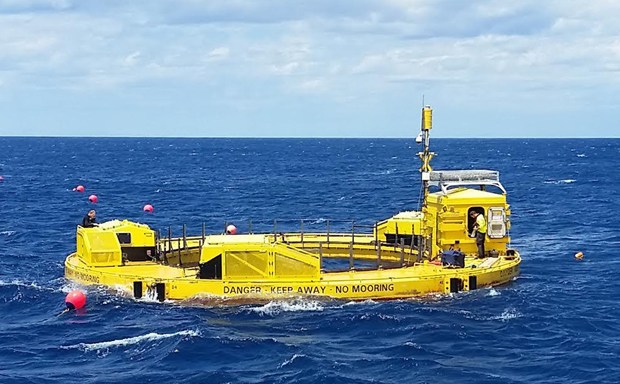America’s first wave-produced power goes online in Hawai’i
 Lifesaver as it was being deployed, in late March 2016. Image courtesy of Sea Engineering, Inc.
Lifesaver as it was being deployed, in late March 2016. Image courtesy of Sea Engineering, Inc.The Hawai‘i Wave Energy Test Site (WETS), the United States’ first grid-connected test site of this kind, was completed by the US Navy in mid-2015. The Hawai‘i Natural Energy Institute (HNEI) is providing key research support to this national effort in the form of environmental monitoring, independent wave energy conversion device power performance and durability analysis, and critical marine logistical support.
Recently, the Navy conducted a blessing and dedication ceremony wherein representatives from the federal and state governments were in attendance, as well as key Department of Defense (DOD) figures.
“There was a high level of enthusiasm for the program to develop this challenging, but potentially extremely rewarding, source of renewable energy,” said Pat Cross, research specialist at HNEI and program manager for WETS.
Located offshore the Marine Corps Base Hawai‘i (MCBH) on the windward side of O‘ahu, a buoy generates electricity with from rise and fall of passing waves. Wave energy has enormous potential to address global renewable energy goals, yet it poses daunting challenges related to commercializing technologies that must produce cost-competitive electricity while surviving the energetic and corrosive marine environment. The nascent commercial wave energy sector is thus critically dependent on available test infrastructure to address these issues.
Through a cooperative effort between the Navy and the US Department of Energy (DOE), WETS will host companies seeking to test their pre-commercial WEC devices in an operational setting, enabling them to advance their device technology readiness level. Initial funding opportunities by Navy and DOE have resulted in a set of five devices to be tested through 2018.
HNEI continues to collect acoustic and other environmental data near deployed wave energy devices, independently monitor their power output and survivability, and work aggressively with Sea Engineering to complete the site-dedicated support vessel. The Northwest Energy Innovations Azura and the Fred Olsen Lifesaver devices, in the water now and producing power, will be followed in 2017 by a larger device developed by Ocean Energy, USA. This technology will be HNEI’s first in the category of oscillating water column devices, in which the waves force air in a chamber through a turbine for power generation.
The results achieved at WETS will have far reaching impacts in terms of advancing wave energy as a whole.
Read more in the Associated Press story (re-posted in the San Francisco Chronicle and CBS News); see also the UH News item.



